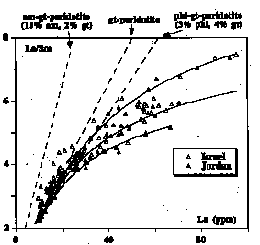
Incompatible element geochemistry of basalts from northern Israel and northeastern Jordan are used to constrain their source and melting behavior. These basalts are part of the Neogene-Quaternary E-Shamma volcanic field, the northern extension of the Western Arabia Volcanic Province (WAVP). It is suggested that patterns shown by ratios of incompatible elements define mixing lines between two lithospheric components - hydrous veins and peridotitic host rocks.
Normalized concentrations of incompatible elements reveal positive anomalies of P and Sr, negative anomalies of Rb and K and steep slopes of M-HREE (Tb/Yb up to 4.2 in basanites). Most of the studied magmas are relatively primary (#Mg>0.55) and show no evidence for fractionation other than olivine and clinopyroxene. Therefore, the wide concentration ranges ("f-enrichment" factors) shown by incompatible elements have to be attributed either to source heterogeneity or to the effects of partial melting. In the case of melting-controlled behavior we would expect Th and Nb to show the highest f-enrichment factors. However, the Israeli-Jordanian magmas show higher f-enrichments for P, Ba and La than for Th and Nb (12.6, 10.9 and 10.1 compared with 8.5 and 5.9, respectively). Patterns shown in diagrams of Nb/Zr vs Nb, La/Sm vs La or the like are usually used to identify melting curves and to constrain source mineralogy. On such diagrams melting produces linear arrays whereas mixing leads to curved lines. Figure 1 shows that the Israeli-Jordanian basalts fall along an upward convexed line, which may be explained as mixing of two end-members. We
identify the end-members as (1) 5-15% partial melting of peridotitic source and (2) an "enriched" component, where the La and P are too high and the Rb and K are too low for being simply a low degree partial melt of the same parental peridotite. Rather this component might be a high-degree partial melt of amphibole, apatite and garnet assemblages. These assemblages are actually found as veins in peridotitic rocks (O'Reilly et al., 1991). Foley (1992) suggested a similar model for potassic magmas, talking about phlogopite-pyroxenite veins. The low Rb and K in the Israeli-Jordanian magmas argue against the presence of phlogopite in the veins. The high Ba and Nb contents may be attributed to the amphibole, while the high P, LREE and Th are due to the presence of apatite (O'Reilly et al., 1991). The high La/Yb ratios (up to 40 in basanites) are attributed to both the high ratios in apatites and the buffering effect of garnet. The mixing hypothesis may also explain the negative correlation between SiO2 and incompatible element concentrations. This is because partial melt of peridotitic source is expected to be silica-rich (Baker et al., 1995) relative to melt coming from amphibole-rich veins.
The lack of potassic magmas and the dominance of amphibole in the source may be explained by a thinner lithosphere underneath the WAVP compared with regions of potassic magmatism.
Baker, M.B., Hirschmann, M.M., Ghiorso, M.S. & Stolper, E.M., Nature 375, 308-311 (1995).
Foley, S., Lithos 28, 435-453 (1992).
O'Reilly, S.Y., Griffin, W.L. & Ryan, C.G., Contr. Miner. Petrol. 109, 98-113 (1991).
Fig. 1: La/Sm vs La in N-Q basalts and basanites from Israel and Jordan. Dashed lines are calculated batch melting curves (<1% up to 20% partial melting) for three different source mineralogies (dry and wet peridotite) using primordial mantle values. Solid lines are calculated mixing lines with three different La-rich end-members. The general pattern shows mixing behavior.